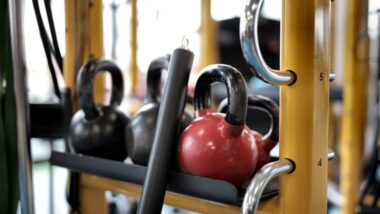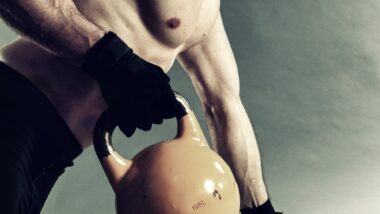Can You Workout With One Kettlebell
With the increasing popularity of kettlebell training, many fitness enthusiasts are wondering whether they can workout with one kettlebell.
While traditional strength training often involves using multiple weights and machines, kettlebell exercises can provide a full-body workout with just one versatile piece of equipment.
However, before embarking on a one-kettlebell workout routine, it’s important to understand the benefits and limitations of this type of training.
Kettlebells are ideal for functional fitness exercises that engage multiple muscle groups at once, making them a popular choice for high-intensity interval training (HIIT) and circuit-style workouts.
A single kettlebell can be used for a variety of exercises, including swings, squats, lunges, presses, and rows. Also, the asymmetrical shape of the kettlebell forces your body to work harder to stabilize itself during movements which increases overall core strength.
However, while it is possible to achieve an effective workout with only one kettlebell in hand, there are certain limitations to consider when creating a comprehensive routine for long-term fitness goals.
Benefits And Limitations Of One-Kettlebell Training
Kettlebell training has become increasingly popular in the fitness industry. It is a versatile workout tool that can be used for strength, cardio, and flexibility training.
One question that often arises is whether you can get an effective workout with just one kettlebell. The answer is yes! While working out with two kettlebells may offer more variety and challenge, working out with one kettlebell can still provide a great full-body workout.
One benefit of using one kettlebell is that it forces your body to work harder to maintain balance and stability. This means that you will engage more muscles in your core, legs, and arms throughout the workout. Additionally, using just one kettlebell allows you to perform unilateral exercises like single-arm swings or lunges which can help improve muscle imbalances and prevent injuries.
However, there are also limitations to using only one kettlebell as some exercises may require two kettlebells to be performed effectively, such as double cleans or snatches.
Functional Fitness Exercises With Kettlebells
Kettlebells are versatile fitness equipment that can be used for a variety of exercises that target different muscle groups. While it is possible to perform a full-body workout with just one kettlebell, it is important to choose the right weight and exercises to ensure an effective workout.
One of the most popular exercises that can be done with a single kettlebell is the swing, which targets the glutes, hamstrings, and back muscles. Other exercises include goblet squats, lunges, presses, and rows.
When working out with one kettlebell, it is important to maintain proper form and technique to prevent injury and maximize results. It may also be helpful to incorporate interval training or circuits to increase intensity and challenge yourself.
Additionally, varying your workouts by changing the weight of your kettlebell or trying new exercises can help prevent boredom and plateauing.
- Try different types of swings such as single-arm or alternating swings for variation.
- Incorporate high-intensity interval training (HIIT) using your kettlebell for an intense cardio workout.
- Add in plyometric movements like jumps or explosive movements like snatches to increase power and athleticism.
- Use your environment! Incorporating outdoor activities like hill sprints or trail runs with your kettlebell can add variety to your workouts.
High-Intensity Interval Training (Hiit) With One Kettlebell
Functional fitness exercises with kettlebells are a great way to build strength and endurance. However, if you only have one kettlebell available, you may wonder if it is possible to get a full workout with just one piece of equipment.
The answer is yes! With some creativity and planning, you can create an effective high-intensity interval training (HIIT) workout that will challenge your entire body and improve your overall fitness.
Incorporating a variety of exercises that target different muscle groups can help you maximize your workout with just one kettlebell. For example, you can perform squat presses for your lower body, bent-over rows for your upper back, and single-arm swings for your core and arms.
By alternating between these exercises in a circuit format, you can create an intense full-body workout that will increase your heart rate and burn calories. To give you an idea of how to structure your workout using one kettlebell, here is an example HIIT workout:
| Exercise | Reps/Set | Sets |
|---|---|---|
| Squat Press | 12-15 | 3 |
| Bent-Over Row | 12-15 | 3 |
| Single-Arm Swing | 30 seconds/side | 4 |
| Goblet Reverse Lunge | 12-15/side | 3 |
| Push-Up with Hand on Kettlebell Handle | 12-15/side | 3 |
Remember to warm up properly before starting any exercise routine and cool down afterwards. By incorporating HIIT workouts with one kettlebell into your fitness routine, you can achieve significant improvements in strength, endurance, and overall health.
Exercises For A Full-Body Workout With One Kettlebell
If you have limited space or resources but still want to maintain your fitness routine, using one kettlebell is an excellent option. This versatile tool can provide a full-body workout that targets different muscle groups and improves cardiovascular endurance.
Here are some exercises you can do with one kettlebell:
- Goblet squats: Hold the kettlebell by the horns close to your chest and squat down until your thighs are parallel to the ground.
- Single-arm rows: Place one hand and knee on a bench or elevated surface and hold the kettlebell in the other hand. Pull it towards your ribcage while keeping your elbow close to your body.
- Turkish get-ups: Lie down on the floor holding the kettlebell with one hand. Use your other arm to push yourself up while maintaining control of the weight throughout the movement.
- Overhead presses: Hold the kettlebell at shoulder height with one hand and press it upwards until your arm is fully extended. Lower it back down slowly.
- Russian twists: Sit on the ground with your knees bent and feet flat, holding the kettlebell with both hands in front of you. Twist your torso from side to side while keeping your core engaged.
Incorporating these exercises into a regular workout routine can help build strength, increase endurance, and improve overall fitness levels without needing multiple pieces of equipment or a gym membership. With consistency and dedication, you can achieve significant results using just one kettlebell as part of your fitness regimen.
Asymmetrical Shape And Core Strength
Having established the efficacy of one kettlebell for a full-body workout, it is important to delve into the unique benefits of asymmetrical shape and core strength.
The uneven weight distribution of a kettlebell requires greater engagement of stabilizing muscles, particularly those located in the core. This translates to an increased intensity and efficiency in exercises performed with a single kettlebell, as opposed to conventional free weights.
Exercises such as the Turkish get-up, windmill and single-arm swing can be modified with one kettlebell for maximum impact on the core. Additionally, performing unilateral exercises with a single kettlebell can help correct muscle imbalances and improve overall balance and coordination.
It is worth noting that proper form is crucial when working out with a single kettlebell, as any deviation from correct technique can lead to injury or ineffective training. With consistency and dedication, incorporating one kettlebell into your fitness routine can significantly enhance your physical performance and aesthetic goals.
Creating A Comprehensive Routine With One Kettlebell
Working out with one kettlebell can be an effective way to achieve your fitness goals. To create a comprehensive routine, it is important to understand the various exercises that can be performed using a kettlebell. Some of the most popular exercises include swings, cleans, snatches, and goblet squats. These exercises target different muscle groups and can be combined in various ways to create a full-body workout.
To make the most of your one kettlebell routine, it is recommended to focus on compound movements that engage multiple muscle groups at once. This not only saves time but also increases calorie burn and improves overall strength. Additionally, incorporating circuits or timed sets can add intensity to your workout and keep you motivated. Remember to start with lighter weights and gradually increase as you master proper form and technique.
- Sub-list 1: Examples of compound exercises include:
- Kettlebell swings
- Goblet squats
- Turkish get-ups
- Sub-list 2: Tips for creating a circuit or timed set:
- Choose 3-5 exercises
- Perform each exercise for a set amount of time (e.g., 30 seconds)
- Rest for a short period between each exercise
- Sub-list 3: Ways to modify your routine:
- Change up the order of exercises
- Increase weight or reps over time
- Add in other forms of cardio or strength training
By following these guidelines, you can create a comprehensive routine with just one kettlebell that targets all major muscle groups and helps you achieve your fitness goals. With consistency and dedication, you’ll soon see improvements in strength, endurance, and overall health.
Long-Term Fitness Goals And Considerations
Having established a comprehensive routine with one kettlebell, it is natural to consider the long-term fitness goals and considerations that come with sticking to such a regimen.
One of the most significant benefits of working out with just one kettlebell is that it helps build strength and endurance, which are essential for living an active lifestyle. Moreover, using a single piece of equipment can help maintain consistency in one’s workout routine, as well as increase focus and intensity during training.
However, while working out with one kettlebell can be highly effective in achieving specific fitness goals, it may not be enough for individuals looking to make significant gains in muscle mass or overall fitness. Therefore, it is important to assess your long-term fitness goals and decide whether or not a single kettlebell will suffice.
Additionally, incorporating other forms of exercise, such as cardio or bodyweight training, can help supplement your kettlebell workout routine and lead to more significant results over time. Ultimately, the key to achieving long-term success with one kettlebell lies in setting realistic expectations and consistently challenging yourself through progressive overload techniques.
Frequently Asked Questions
How Heavy Should My One Kettlebell Be For A Full-Body Workout?
When it comes to picking a kettlebell weight for a full-body workout, there are a few factors to consider.
First and foremost, it is important to choose a weight that you can comfortably and safely handle while performing exercises with proper form.
Additionally, the weight should be challenging enough to provide an effective workout but not so heavy that it causes strain or injury.
A general rule of thumb is to start with a weight that is around 30-35% of your bodyweight for upper body exercises and 50-60% of your bodyweight for lower body exercises.
However, it ultimately depends on your fitness level and individual goals.
Remember, consistency and gradual progression are key components to achieving results with any workout routine.
Can I Still Build Muscle With Just One Kettlebell?
When it comes to building muscle with just one kettlebell, the answer is yes, it’s possible.
While having a variety of weights and equipment can be beneficial for targeting specific muscles and achieving progressive overload, a single kettlebell can still provide an effective full-body workout.
By utilizing different exercises and varying the weight, repetitions, and rest periods, you can challenge your muscles and continue to see progress over time.
However, it’s important to remember that nutrition and recovery also play a significant role in muscle growth.
So whether you have access to one or multiple kettlebells, consistency and proper training principles are key for achieving your fitness goals.
Are There Any Safety Concerns When Working Out With One Kettlebell?
When working out with a single kettlebell, it is important to be mindful of potential safety concerns.
One issue to consider is the imbalance of weight distribution, which can put unnecessary strain on one side of the body and lead to muscle imbalances.
To prevent this, it is recommended to perform exercises with both sides of the body equally and use proper form.
Additionally, it is important to choose an appropriate weight for your fitness level and gradually increase intensity as you become stronger.
Overall, incorporating a single kettlebell into your workout routine can be an effective way to build strength and improve overall fitness, but it is crucial to prioritize safety and technique in order to avoid injury.
Can I Use A One Kettlebell Workout As My Only Form Of Exercise?
A one kettlebell workout can be an effective addition to your fitness routine, but it should not be the only form of exercise you engage in.
While kettlebells are versatile and can target multiple muscle groups, relying solely on one piece of equipment may lead to imbalances and limitations in your overall fitness level.
It is important to incorporate a variety of exercises, including resistance training, cardio, and flexibility work, to promote a well-rounded approach to fitness.
Additionally, consulting with a certified personal trainer or fitness professional can help create a customized workout plan that meets your specific needs and goals.
How Often Should I Switch Up My One Kettlebell Routine To Prevent Plateaus?
To prevent plateaus in your workout routine, it is recommended to switch up your exercises every 4-6 weeks.
This is especially important when using a single kettlebell as your primary form of exercise.
Incorporating new movements and variations can challenge your muscles in different ways and keep them guessing, leading to continued progress and growth.
It’s also important to focus on proper form and gradually increasing the weight of your kettlebell as you become stronger to ensure continued improvement.
By regularly switching up your one kettlebell routine, you can avoid hitting a plateau and continue making progress towards your fitness goals.
Conclusion
When it comes to fitness, many people wonder if they can achieve a full-body workout with just one kettlebell. The answer is yes, but it depends on the weight of the kettlebell and the type of exercises performed.
Ideally, your kettlebell should be heavy enough to challenge you but not so heavy that it compromises your form. With proper technique, a one kettlebell workout can still help you build muscle and improve overall strength.
However, safety concerns must be addressed, such as ensuring you have enough space to move and avoiding overexertion. It’s also important to change up your routine regularly to prevent plateaus and ensure ongoing progress.
Overall, a one kettlebell workout can be an effective way to achieve a full-body workout without needing access to a full gym or multiple pieces of equipment. Just be sure to choose the right weight for your fitness level and take precautions to avoid injury. With consistency and dedication, you can achieve your fitness goals with just one kettlebell in hand.


